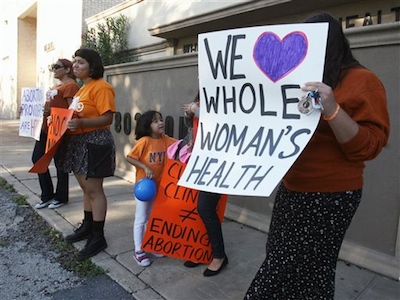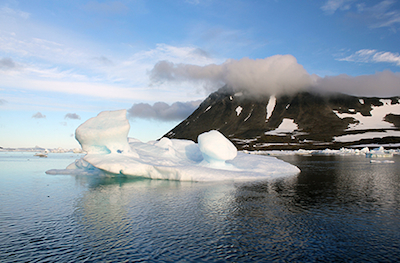Dear Friend and Reader:
Just as environmental ecology takes into account the interconnection of animal and plant species, geology and climate, so too does human ecology need to see the big picture of interlocking factors that determine health and wellbeing. In a startlingly clear correlation, Ibis Reproductive Health and the Center for Reproductive Rights released a study Wednesday showing that U.S. states with the highest number of restrictions on abortions score lowest on indicators for women’s and children’s health, Huffington Post reported Oct. 1.
 |
|
Protesters in front of the Whole Woman’s Health clinic Saturday, Oct. 4, 2014, in McAllen, Texas; Thursday a federal appeals court allowed stringent new abortion restrictions to take effect, closing overnight all but eight abortion clinics in the second-largest U.S. state. Texas already had a high number of abortion restrictions and a low rating for women’s and children’s health. Photo by Joel Martinez.
|
“This report exposes the flimsy claims of politicians who have been shutting down women’s health care providers under the patently false pretext of protecting women’s health,” said Nancy Northup, president and CEO at the Center for Reproductive Rights. “It clearly demonstrates how women and families have suffered as politicians put their ideological agenda before the real needs of their constituents.”
States in the U.S. have passed more abortion restrictions in the last three years than in the entire previous decade.
The study’s authors write, “With few exceptions, states that have passed multiple policies to restrict abortion have passed fewer evidence-based policies to support women’s and children’s well-being, compared to states with fewer restrictions on abortion.”
Vermont was the only state with zero restrictions; Kansas, Mississippi and Oklahoma top the list with fourteen anti-abortion laws each.
For extra credit, you can check how the graphs in the Ibis study correlate with the maps created by the Centers for Disease Control showing the rates of sexually transmitted infections by state.
You Don’t Need Plastic Microbeads in Your Mouth
Toothpaste manufacturer Crest has announced it will remove microbeads from all its products by March 2016, according to a Sept. 18 article on Yahoo! Health. The news followed reports that the non-biodegradable polyethylene beads were found in several dental patients’ mouths — lodged in the sulcus, a narrow channel between gums and teeth that can often initially host diseases like gingivitis.
Dental hygienist Trish Walraven told Dental Buzz: “What I am saying definitively is that plastic is in your toothpaste, and that some of it is left behind even after you’re finished brushing and rinsing with it.”
 |
|
Photo of toothpaste continaing microbeads by SimonQ/Qiameng under Creative Commons license.
|
Microbeads apparently are added to toothpaste for decoration — presumably to make them look ‘sparkly’ and send a subliminal message that your teeth will get and look cleaner.
“People think since the beads are in body scrub, they might help polish the teeth,” Jennifer Jablow, a cosmetic dentist in New York City, told Yahoo! News. “They actually don’t.”
Polyethylene microbeads may also be presenting problems in our waterways. As Planet Waves reported in August 2013, (scroll down to the ECO section), researchers with the non-profit environmental activist group 5 Gyres Institute found large quantities of round plastic pellets less than a millimeter in size in water samples from lakes Erie, Superior and Huron in 2012.
Presented with the group’s findings, Johnson & Johnson told 5 Gyres they were already in the process of phasing out microbeads from their body care products; Proctor & Gamble (which owns Crest) had plans to phase out microbeads by 2017. March 2016 is certainly sooner than that, but one has to wonder why it should take so long as the evidence mounts against microbeads.
Leaked Trade Agreement Doc Pushes Chemical Industry Agenda
Common Dreams reported Oct. 1 that a leaked text from the Transatlantic Trade and Investment Partnership (TTIP — a trade coalition of American and European governments) reveals proposals by the European Commission that would fall in line with the chemical industry’s agenda and “hinder the development of stronger controls for toxic chemicals on both sides of the Atlantic.”
Says Vito Buonsante, Law and Policy Adviser with ClientEarth, “the E.U. is giving the U.S. a chance to block any initiative to protect E.U. citizens and environment from the risk from toxic chemicals. TTIP could erase all progress which has been made in the E.U. to ensure precautionary decision making on chemicals.”
 |
ClientEarth, the Center for International Environmental Law and Natural Resources Defense Council have released an analysis of the leaked document.
Cecilia Malmstrom of Sweden, the nominee to be the European Union’s next trade commissioner, “called for throwing the trade negotiations open to fuller public scrutiny to quell fears in Europe that cherished social and environmental safeguards might be compromised in any pact with the United States,” according to The New York Times.
Any such transparency would be a sharp about-face in the TTIP process. Secrecy surrounding the TTIP talks has been unprecedented; in the talks for a Free Trade Area of the Americas, for example, negotiating texts would be released to the press after each round of talks. This was the seventh round of TTIP negotiations
Two-Degree Global Warming Limit Defended
Claims in a recent Nature article that the two-degree Celsius global warming limit should be waived are nonsense, climatologist Stefan Rahmstorf wrote on the RealClimate site Oct. 1.
David G. Victor and Charles F. Kennel, authors of the Nature article, argue that while the two-degree limit has spurred action and provided a goal people can grasp intellectually, it is too simplistic and has offered politicians a way to boast that they are mitigating global warming without doing much.
 |
|
One reason the two-degree Celsius limit matters is that if the Greenland Ice Sheet melts, the global sea level could rise by seven meters. Photo of Kulusuk, Greenland by Chelsea Bottinelli.
|
“It is time to track an array of planetary vital signs — such as changes in the ocean heat content — that are better rooted in the scientific understanding of climate drivers and risks,” Victor and Kennel write. “Targets must also be set in terms of the many individual gases emitted by human activities and policies to mitigate those emissions.”
Rahmstorf is clear that he does not disagree with the idea of augmenting the two-degree limit by tracking other planetary vital signs. The danger, he says, is in offering up any idea world leaders might latch onto that could be used as an excuse to unravel what progress has been made on mitigating global warming:
“If one wanted to sabotage the chances for a meaningful agreement in Paris next year [at the U.N. climate summit], towards which the negotiations have been ongoing for several years, there’d hardly be a better way than restarting a debate about the finally-agreed foundation once again, namely the global long-term goal of limiting warming to at most 2 °C,” writes Rahmstorf. “This would be a sure recipe to delay the process by years. That is time which we do not have if we want to prevent dangerous climate change.”
Scientists at the German non-profit organization Climate Analytics have also rebuffed Victor and Kennel.
With new evidence suggesting the threshold for this and other catastrophic events might be even lower, Rahmstorf is clear: above two degrees, “the planet will be hotter than anything experienced during human civilisation.”
Rahmstof’s rebuttal came roughly one week after the National Oceanic and Atmospheric Administration released data confirming that the summer of 2014 was the hottest summer on record for the planet since 1880.
Something Is Rotten at the Site of Hanford
Repeated missed deadlines for the cleanup of the Hanford nuclear production complex have prompted the state of Washington to take legal action, The Associated Press reported Oct. 2.
 |
|
Not to make light of the Hanford situation, but in 2009 a helicopter was used to locate radioactive droppings; rabbits had been routinely burrowing beneath the waste storage tanks and eating radioactive caesium and strontium salts. Image by Carl Stoiber.
|
In an ongoing dispute against the U.S. Department of Energy (DOE), state Gov. Jay Inslee and Attorney General Bob Ferguson said the state will file a motion in federal court — asking the court for new requirements for the retrieval and treatment of tank waste as well as the construction of more durable tanks.
“We need much stronger accountability to ensure our citizens are protected and the Hanford site is cleaned up,” said Inslee.
The DOE is asking to amend a 2010 court order because it cannot meet the imposed deadlines for the waste cleanup and new tank construction, and claims that on several occasions it has told the state of Washington that it cannot meet the deadlines.
Meanwhile, taxpayers are shelling out $2 billion a year to clean up what, exactly? Oh, just the costs of ‘green, nuclear energy.
In related news, workers at the mostly decommissioned Hanford Site continue to suffer from symptoms of toxic exposure. Seattle’s KING-TV 5, an NBC affiliate, reported Oct. 2 that four exposed workers, from two separate incidents, were evaluated by medical professionals last Thursday.
As usual, the workers were treated at an on-site medical facility and were cleared to return to work. In 56 separate incidents since March of this year, workers at Hanford have received medical care after reporting symptoms of toxic vapor exposure; the vapor is continuously leaking from 177 underground tanks holding waste from plutonium processing awaiting the DOE’s action.
Public Comment Re-Opened for National Forest War Games
Electromagnetic war games are scheduled for Olympic National Forest and three other sites located in Washington state on Department of Natural Resources land, Peninsula Daily News reported Sept. 28. The Navy hopes to begin in September 2015.
 |
|
Section of a panoramic photo showing the Buckhorn and Iron Mountains from Marmot Pass on the Olympic Peninsula. Photo by Gregg M. Erickson/Farwestern under Creative Commons license.
|
Three camper-sized trucks containing electromagnetic radiation equipment would “simulate modern [electronic warfare] threats in an open-air environment to effectively and efficiently train the operators of these systems,” along with Navy aircraft.
Officials claim that the trucks would be cordoned off with taped barriers and warning signs, and situated on ridges and cliffs with emissions pointed toward open areas. If humans or large animals wander into the area and refuse to leave, the electromagnetic transmissions will cease until the area is clear.
Greg Wahl, project lead and an environmental coordinator for the U.S. Forest Service, determined the project would have “no significant impact,” yet the assessment notes that, “Human tissue is directly susceptible to shock or burns when metallic objects, which have absorbed high electromagnetic radiation, are touched,” and classifies links to cancer and similar issues as “speculative.”
Dean Millett, district ranger for the Pacific District of the Olympic National Forest initially agreed with the Navy’s assessment of “no significant impact,” but has since reopened the proposal to public comment; the window to comment ends Oct. 10.
Questions or comments about the project should be directed to Whal at gtwahl@fs.fed.us.
Is anyone else wondering why national forests are available for warfare training?
Yours & truly,
![]()
Amanda Painter and the ECO editorial team
You may forward Planet Waves Monsanto Eco to your friends. They can sign up for this free environmental newsletter from Planet Waves. View this edition as a webpage.
Planet Waves Monsanto Eco (ISSN 1933-9135) is published each Tuesday evening in Kingston, New York by Planet Waves, Inc. Publisher: Eric Francis Coppolino. Editor: Amanda Painter. Business Manager: Chelsea Bottinelli. Web Developer: Anatoly Ryzhenko. Research, Writing and Editing: Planet Waves Monsanto Eco is produced by a team consisting of Amy Elliott, Carol van Strum, Len Wallick and Chad Woodward.

























